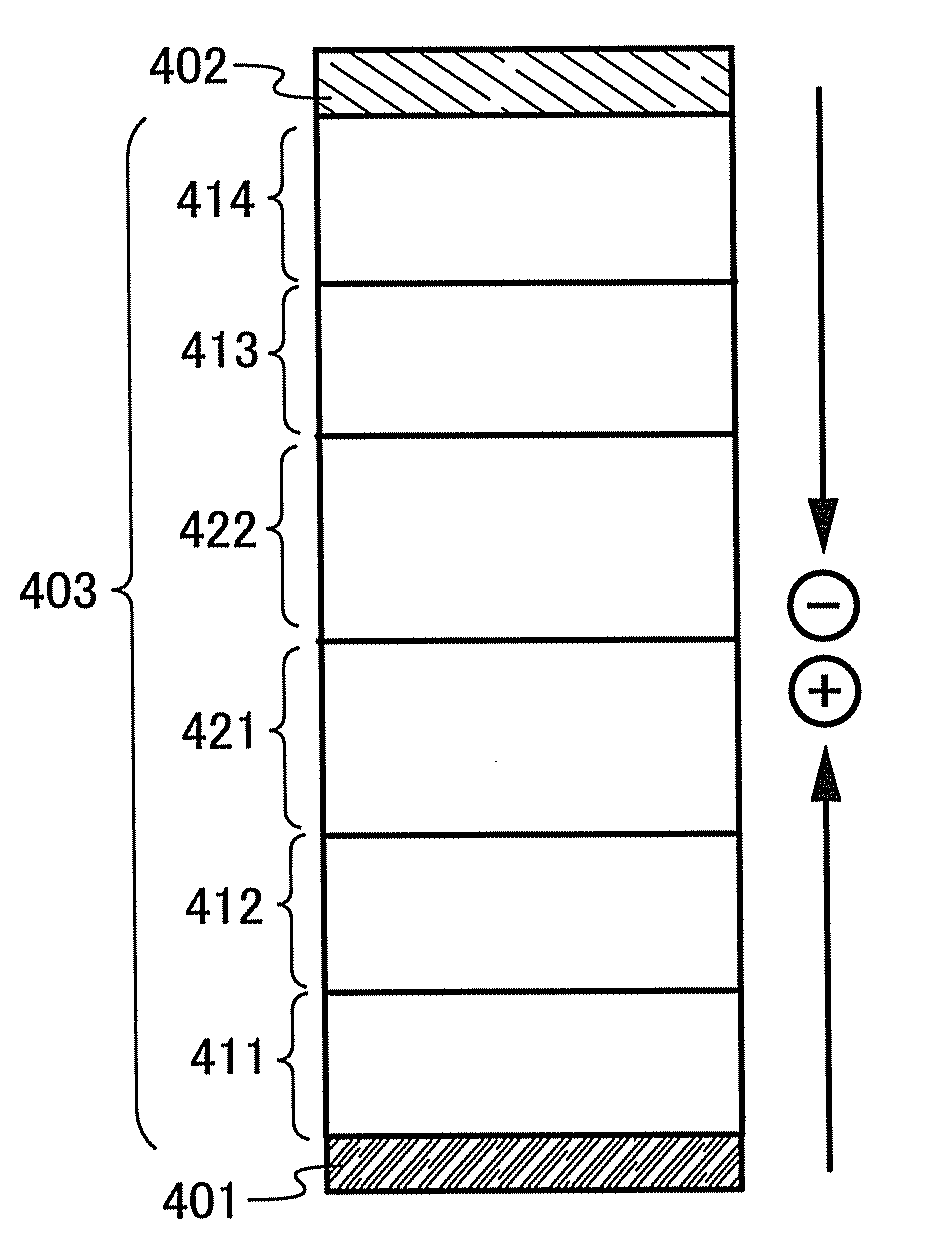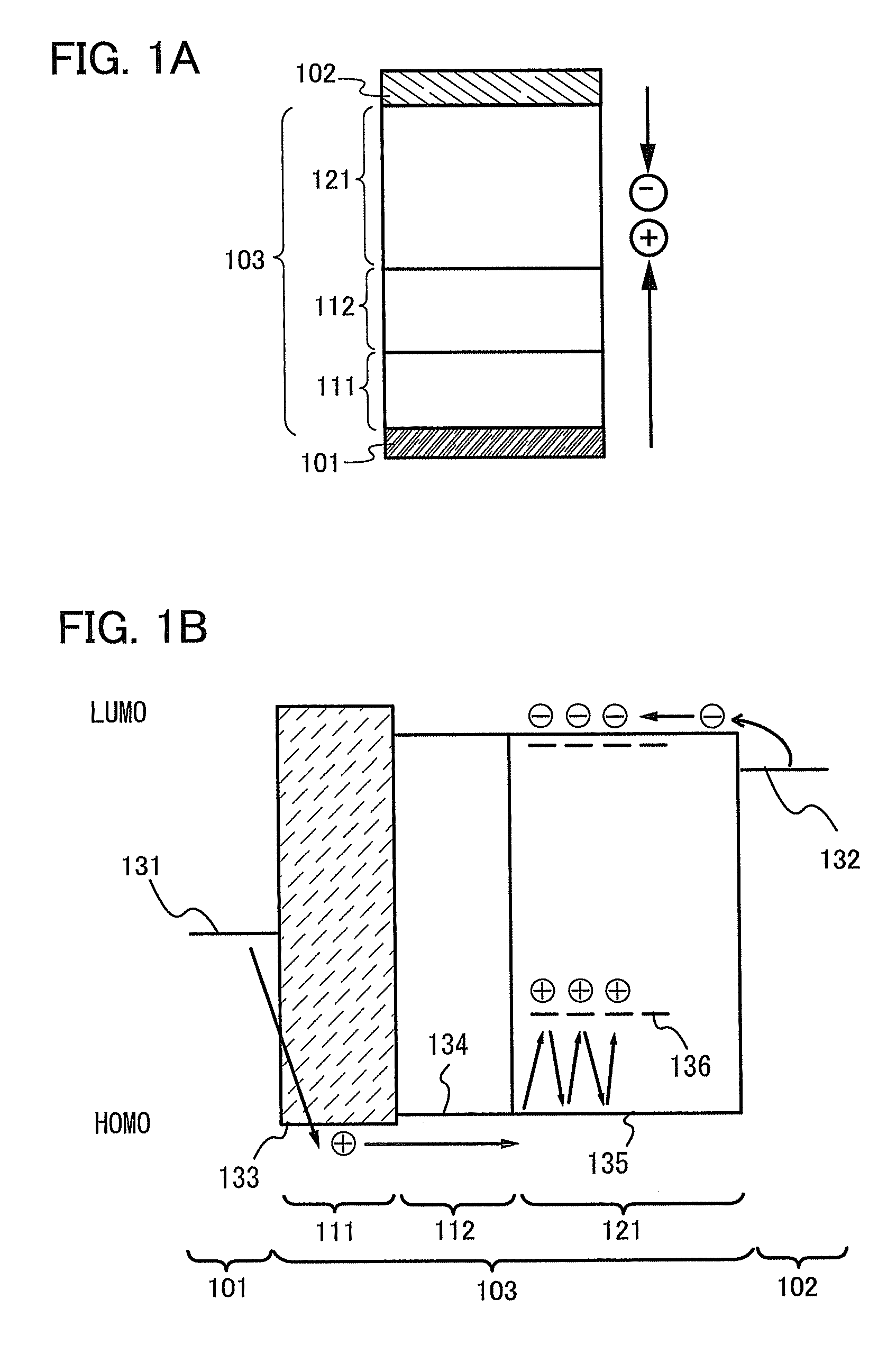Light-emitting element, light-emitting device, electronic device, and lighting device
a technology of light-emitting elements and light-emitting layers, which is applied in the direction of organic semiconductor devices, discharge tubes luminescnet screens, natural mineral layered products, etc., can solve the problems of difficult substantial removal of elements, inability to realize the work function of anodes, and inability to meet the homo level of light-emitting layers, etc., to achieve excellent emission efficiency and drive voltage, long life, and long life
- Summary
- Abstract
- Description
- Claims
- Application Information
AI Technical Summary
Benefits of technology
Problems solved by technology
Method used
Image
Examples
embodiment 1
[0091]Embodiment 1 will provide descriptions of a structure of a light-emitting element which is one embodiment of the present invention referring to a material to be used and a fabrication method. In Embodiment 1, a region interposed between an anode and a cathode is called an EL layer.
[0092]First, FIGS. 1A and 1B illustrate respectively a conceptual element structure and its band diagram of the light-emitting element of one embodiment of the present invention. For comparison, FIGS. 2A and 2B illustrate respectively a conceptual element structure and its band diagram of a conventional light-emitting element.
[0093]FIG. 2A illustrates the element structure of the conventional light-emitting element as described in, for instance, Non-Patent Document 3, which has an EL layer 203 provided between an anode 201 and a cathode 202. The EL layer 203 has a stack structure where a hole-injection layer 211, a hole-transport layer 212, and a light-emitting layer 221 are provided in order from th...
embodiment 2
[0160]Embodiment 2 will provide descriptions of a structure preferred for higher carrier recombination efficiency of the light-emitting element which is one embodiment of the present invention, referring to a material to be used and a fabrication method. In Embodiment 2, a region interposed between an anode and a cathode is called an EL layer.
[0161]FIGS. 4A and 4B illustrate respectively a conceptual element structure and its band diagram of the light-emitting element of one embodiment of the present invention in Embodiment 2. As illustrated in FIG. 4A, in a light-emitting element of one embodiment of the present invention, an EL layer 403 is provided between an anode 401 and a cathode 402. The EL layer 403 at least has a stack structure where a first layer 411, a second layer 412, a first light-emitting layer 421, and a second light-emitting layer 422 are provided in order from the anode 401. Further, the first layer 411 contains the first organic compound and the electron-acceptin...
embodiment 3
[0217]This embodiment will provide descriptions of a structure of the light-emitting layer, which is different from those in Embodiments 1 and 2. Note that a structure of a light-emitting element will be described using FIGS. 1A and 1B.
[0218]In FIGS. 1A and 1B, although the light-emitting layer 121 includes the third organic compound and the light-emitting substance having a hole-trapping property with respect to the third organic compound according to Embodiment 1, the light-emitting layer 121 includes a light-emitting substance capable of emitting light (a substance having a light-emitting property) which is different from the light-emitting substance having a hole-trapping property according to Embodiment 3. That is, the light-emitting layer 121 of this embodiment includes the substance having a light-emitting property in addition to the light-emitting substance having a hole-trapping property.
[0219]Since the structure in FIGS. 1A and 1B according to Embodiment 3, which is except...
PUM
| Property | Measurement | Unit |
|---|---|---|
| HOMO | aaaaa | aaaaa |
| LUMO | aaaaa | aaaaa |
| HOMO level | aaaaa | aaaaa |
Abstract
Description
Claims
Application Information
 Login to View More
Login to View More - R&D
- Intellectual Property
- Life Sciences
- Materials
- Tech Scout
- Unparalleled Data Quality
- Higher Quality Content
- 60% Fewer Hallucinations
Browse by: Latest US Patents, China's latest patents, Technical Efficacy Thesaurus, Application Domain, Technology Topic, Popular Technical Reports.
© 2025 PatSnap. All rights reserved.Legal|Privacy policy|Modern Slavery Act Transparency Statement|Sitemap|About US| Contact US: help@patsnap.com



